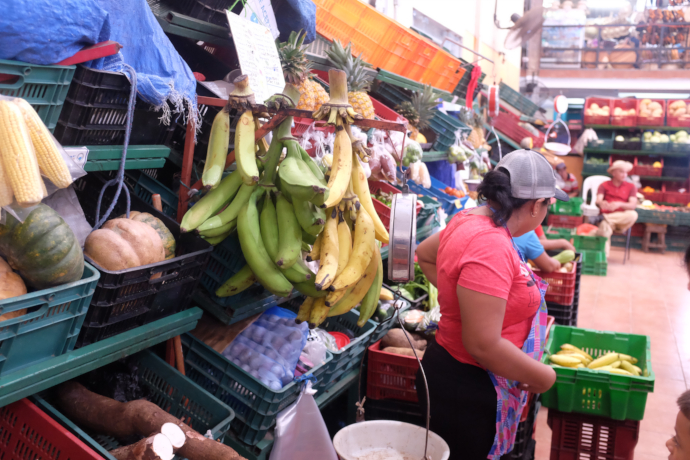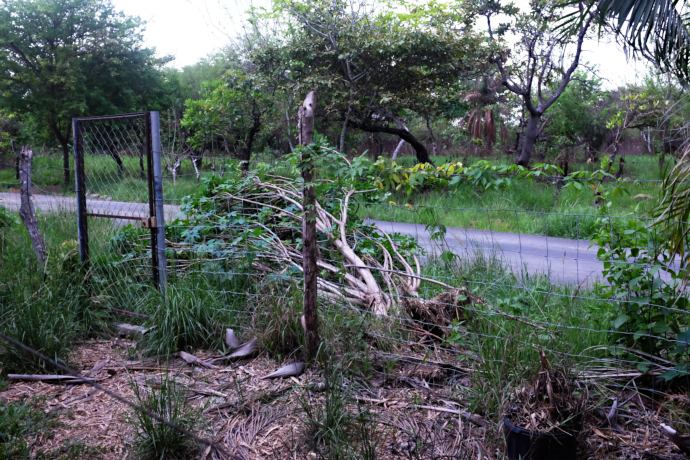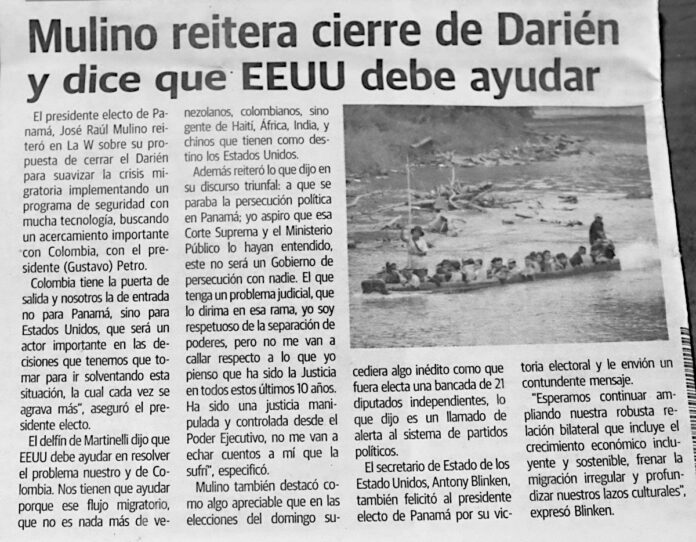President Cortizo and President-elect Mulino in a courtesy visit at the Palacio de las Garzas after the election. The “official” transition period begins on June 3 and the inauguration / changing of the guard for all elected offices happens on July 1. Photo by the Presidencia.
National unity, or just the same old families? Or do we see something actually new?
by Eric JacksonJuly
President-elect José Raúl Mulino held his first collective cabinet photo-op for selected rabiblanco media on the morning of May 16, but his first half-dozen ministers were revealed the day before, and his transition chief some days before that.
Just who is going to lead the fragmented new National Assembly is up in the air. The legislature’s leaders will be elected on July 1, and one way to look at Mulino’s cabinet choices could be as how they might attract or alienate a legislative majority with which he’ll likely have to work.
So far it appears that the cabinet will above all come from the wealthy oligarchic fringes of Panama’s small white minority, with some exceptions coming from law enforcement subordinates from Mulino’s days as Ricardo Martinelli’s security minister. Some of the extended clan of the fugitive Ricardo Alberto Martinelli Berrocal and his wife Marta Linares de Martinelli are included, or seem to be. Mulino made his courtesy call on Cortizo accompanied by journalist Rafael Berrocal as well as his transition chief, but we don’t know if either of those two will go on to occupy formal posts once the new government is in place.
Here are the first of his picks:
Minister of Economy and Finance: Felipe Chapman Arias
This 55-year-old lawyer, economist and consultant is the son of a father who occupied a comparable position in the 1994-1999 PRD administration of Ernesto “Toro” Pérez Balladares. Like his father Guillermo Chapman Fábrega he’s known to be an advocate for neoliberal economic theories and consequent government policies. He was early to sound an alarm after the Supreme Court for the second time struck down the mining concession originally granted to imprisoned fraud artist Richard Fifer but ultimately subdivided with a part eventually passing into the hands of Canadian-based multinational mining company First Quantum. The research and consulting company of which he’s a partner, Investigaciónes y Desarrollo SA (INDESA), mostly works for banks and corporations as clients. He’s a partner in the Rosas y Rosas law firm and on the board of directors of Banco del Istmo. In the past he supported the mining colony contract with First Quantum and the privatization of the IDAAN water and sewer utility.
Minister of Foreign Relations: Javier Martínez Acha
60-year-old Martínez is a member of the PRD and of the family that owns the Casa del Mariscos restaurant, where he tends to hang out and hobnob with a variety of political figures. He’s a lawyer, economist and civil engineer mostly educated at Texas A&M, a popular school for rich Panamanians to send their kids. (Family ties are a big thing in Panamanian politics, but Aggie ties are also a factor here.) He has been working as general manager of Geneva Asset Management, SA. Over the years Martínez Acha served on the PRD’s National Executive Committee and in a now-deleted introduction to his Twitter feed he described himself as a social democrat.
As vice ministers Mulino has chosen Florida State University – Panama international relations and political science professor Carlos Guevara Mann, leader of Panama’s pan-Latin American Bolivarian Society and frequent La Prensa columnist; and Carlos Ruiz-Hernández, former Panamanian ambassador at the United Nations in Martinelli times who has since then worked for the Washington-based arbitration firm Allen & Overy LLP.
Minister of the Environment: Juan Carlos Navarro Quelqueju
Navarro, the former PRD mayor of Panama City and that party’s 2014 presidential standard-bearer, is the scion of the Tropigas fortune and was founder of the National Association for the Conservation of Nature (ANCON). In recent years he has been building a solar panels business. Navarro has vociferously embraced a couple of causes in the past year or so: he was strongly opposed to the mining deal with First Quantum and advocates the closure of the border with Colombia for environmental reasons. The consolidation of Benicio Robinson’s power over and within the PRD pretty much coincided with Navarro’s eclipse in that party’s power circles. NOT an Aggie — he’s a Dartmouth and Harvard grad.
Minister of Public Safety: Frank Ábrego Mendoza
61-year-old Ábrego, educated at the General Francisco Morazán Military Academy in Honduras, the old US Army School of the Americas (now called the Western Hemisphere Institute for Security Cooperation) and the US Army Special Forces Officers’ School, was one of Noriega’s boys, personal friend of the strongman and active-duty Panama Defense Forces at invasion time. A Santeño by birth, he was one of the PDF guys who survived the post-invasion purges and became part of the renewed police force. As a cop he did riot control, anti-terrorist and border patrol duties, then was the founding director of the National Border Service (SENAFRONT) when it split off from the National Police in 2008, until he took his retirement from law enforcement in 2016. However, after his police career Ábrego served as a security consultant to presidents Varela and Cortizo. It is said that one of Ábrego’s heroes is the late General Omar Torrijos. In Martinelli times, with Ábrego as its director, SENAFRONT was brought into the cities as an elite riot squad and was widely criticized for its brutality in Colon.
Minister of Labor: Jackeline Muñoz de Cedeño
She’s the daughter of José Muñoz Molina, founder of the small Alianza Party that was in Mulino’s coalition with the Martinelistas. Currently she’s a deputy in the Central Americana Parliament (PARLACEN) and also alternate representante of the Panama City corregimiento of Tocumen. A Panama-educated lawyer, she practices family and immigration law. She was the running mate of the self-proclaimed “sexual buffalo,” RM mayoral candidate Sergio Gálvez, in an ill-fated run for the Panama City mayor’s office.
Minister of Health: Dr. Fernando Boyd Galindo
Dr. Boyd Galindo is a dentist specializing in periodontics, educated at the University of Panama and the University of Pennsylvania. He taught that specialty at the University of Panama in the 1980s and 90s. he served a chair of the Social Security Fund (CSS) board of directors from 1990 through 1996. He was president of the Panamanian Dental Association in 1987 and 1988.
Chief of the transition team: Aníbal Galindo Navarro
Galindo is an attorney, of the family that created the medicine importers’ cartel. Among his clients was the mining company First Quantum, but it seems that his practice has mostly been offshore asset protection. He was vice president of Cambio Democratico when Martinelli still controlled it and was an advisor to Martinelli and an ambassador in Qatar during that presidency.
Contact us by email at thepanamanews@gmail.com
To fend off hackers, organized trolls and other online vandalism, our website comments feature is switched off. Instead, come to our Facebook page to join in the discussion.
These links are interactive — click on the boxes
>


































